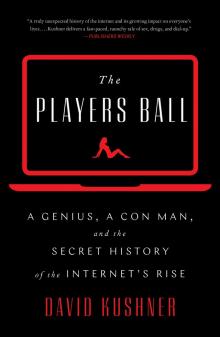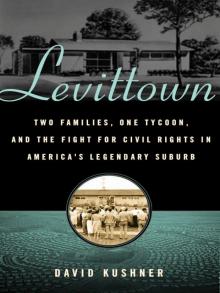- Home
- David Kushner
Levittown Page 2
Levittown Read online
Page 2
In lieu of a high school degree, Abe took the state regents exam and passed. At the turn of the century, he was twenty and ready to put his self-taught brains to professional use. He entered law school at New York University, where he stood out for his drive and gumption. As a sophomore, he wrote a book on real estate called Levitt’s Notes on Law and used the proceeds to pay off his tuition. Abe completed his degree in just two years and conquered the bar exam the next year, in 1903. Abe specialized in real estate law and earned enough to buy a four-story brownstone on leafy Macon Street in Brooklyn.
Though a quiet and contemplative young man, he chose a large and outgoing woman for his wife—Pauline A. Biederman. As his family would later joke, Abe started his marriage at six foot three, but ended up ground down to five four by the time Pauline was done with him. Though not wealthy, the Levitts had enough money to have domestic help and the leisure to stroll through the nearby parks. The once poor immigrant had finally come into his own small piece of the American Dream. It was time to have children. When their first son was born on February 11, 1907, they named him William Jaird.
Brothers fight. And, after Abe and Pauline had their second child, Alfred Stuart, on March 12, 1911, there was plenty of fighting—good-natured and otherwise—in the Levitt home. Abe set the tone. As in building a start-up business, he wanted a snappy, do-it-yourself, bootstrapping crew on his ship. Arguing—both to defend a point and to build one’s character—was encouraged. “It is generally a good thing to have a lawyer father who will kick you into college and present you with some social arguments once in a while,” Alfred later said. “Self-confidence waxed mightily,” Bill recalled. Bill, bold and outgoing, gravitated to the lectures on baseball, particularly on the family’s favorite team, the Dodgers. Alfred, introspective and reserved, took to the discussions of art.
From an early age, the boys possessed competitive, though complementary, differences. One day, the brothers snuck up to the attic and found some antique swords. They dueled with each other until Bill inadvertently took a slice out of Alfred’s thumb. The thumb was sewn back up, but the split between the brothers would always remain.
Bill had his mother’s tough streak. He never hesitated to speak his mind. Upon overhearing his father’s business escapades, he would pipe in to say, “You’ll never get rich that way.” Abe marveled that his eleven-year-old son thought he needed his advice. At PS 44 and Boys High School in Bedford-Stuyvesant, Bill competed in lacrosse and swimming. In his teens, Bill gravitated to the high life, with a taste for money, attractive women, and sports cars. He wore the latest fashions, like tailored plus-four pants, cut four inches below the knees. In one photo, he posed in his plus fours, cockily, leaning against a Model T. One morning, he arrived at breakfast dressed to the nines. “Where you going all dressed up like that?” his parents asked. “I’m off to Manhattan,” he replied. “I’m going to buy the Chrysler Building!”
While his older brother chased his dreams of power and fortune, Alfred preferred more intellectual pursuits such as chess, and reading. Fascinated by technology, he’d spend hours reading science-fiction and fantasy stories, particularly those in the pioneering sci-fi magazine Amazing Stories. Before long, the family would find him alone in his room, sketching futuristic buildings on an artist’s pad. “Alfred is a genius,” his father would say, “and I use that term advisedly.” But, at times, it seemed as though their mother, Pauline, played favorites. On occasion, she would call for Alfred from across the brownstone. It’s me she wants, he would think. She would pull Alfred close and bring his little ear to her lips. “Where’s your brother, Bill?” she would whisper.
But Bill was off. At sixteen, he entered his father’s alma mater, New York University, where he made a go at studying English and math. The distractions proved too strong. Bill began dating a pretty girl, Rhoda Kirshner, from the Bronx. He grew restless and dropped out of NYU in his third year at age nineteen in 1927. When later asked why, he replied, “I got itchy, I wanted to make a lot of money. I wanted a big car and a lot of clothes.”
His father obliged, taking his eldest son under his wing at his law firm. Around that time, Abe acquired land in Rockville Centre, Long Island, an up-and-coming commuter area on the South Shore, from a client who had defaulted on his payments. The housing market of the 1920s had reached a high point of $4.5 billion in 1925 and had been falling since—as far down as $2.45 billion by 1929. With many losing money, it was a time, as one writer put it, “when anyone who even mentioned building a home for sale was ripe for the booby hatch.”
But the Levitts had the guts to roll the dice. In a project that branched out beyond the law firm’s ordinary activities, the Levitts completed and sold forty homes on the Rockville property. The experience invigorated young Bill, who had, as he said, been itching to get into industry. It also intrigued his brother, Alfred. After studying art for a year at NYU, he had marched into his dean’s office and announced that he was dropping out because the school had nothing to teach him. Designing and selling homes, on the other hand, could let both him and Bill both explore their interests, hands-on. All they had to do was make it official. So they created a company with their father devoted to building: Levitt & Sons.
At just twenty-two, Bill became president and designated front man—tasked with advertising, sales, and financing. He had matured into a tall, handsome young man, with bushy eyebrows, tight, curly black hair, and sad, droopy eyes. Alfred, eager to flex his nascent interest in architecture and art, became the eighteen-year-old vice president of design. He had the look of an artist, with fashionable glasses and a wry smile. Though their differences were still profound, their father saw in them, as a team, something dynamic. “Bill wouldn’t be a success without Alfred, and Alfred wouldn’t be a success without Bill,” Abe would say. “Together they are terrific.”
Alfred, with no architectural training, took to the task like a nerd to a chemistry set. He sketched a six-room, two-bath, Tudor-style, half-timbered home, then watched with delight as the house went up over the summer of 1929. Bill brought it to market for a high price of $14,500. On August 2, Abe’s forty-ninth birthday, his sons gave him the ultimate present: the company’s first sale. Levitt & Sons was in business. And they saw their new frontier: suburbia.
Suburbia was an invention, like any other, but it was hardly new. Through and long past the Middle Ages, the dream of a country home near the city was the domain of the elite. English manor homes in the 1600s gave way to sprawling estates for dukes and duchesses in the 1800s. The dream spread to North America. Thomas Jefferson said, “I view large cities as pestilential to the morals, the health, and the liberties of man.”
Starting in 1815, innovations in transportation—steamboats, railroads, and horse-drawn carts—gave city dwellers new ways to escape the urban noise and dust. And they did, heading off in droves for what would become the first wave of planned suburbs. Cambridge and Somerville bloomed outside Boston. Brooklyn Heights absorbed movers and shakers from across the river in New York City. Llewellyn Park, New Jersey, would soon define some of the essential features for suburban communities—from the curvilinear roads to the green parks in the center of the developments.
And there were more and more reasons to leave the city. Outbreaks of diseases such as cholera and smallpox ravaged the crowded cities, adding to the appeal of living in a spacious, natural environment nearby. As the nineteenth century progressed, life in suburbia took on more allure. Brooklyn bard Walt Whitman wrote, “A man is not a whole and complete man unless he owns a house and the ground it stands on.” Frederick Law Olmsted, the designer of Central Park in New York, said, “No great town can long exist without great suburbs.”
Books on landscaping and lawn care—aimed at the suburban homeowner—hit the shelves. One scribe, Frank J. Scott, author of The Art of Beautifying Suburban Home Grounds, wrote, “A smooth, closely-shaven surface of grass is by far the most essential element of beauty on the grounds of a suburban house.” Again,
new technologies met the demands, as lawn-mowing machines hit the market in the mid-1800s. And so that homeowners didn’t have to busy themselves watering their grass, a patent was issued in 1871 for the first lawn sprinkler.
Suburbia was a desirable destination for those who could afford it. Railroads enabled a new commuting culture, but only the wealthy could have a horse and driver greet them at the station and take them home. With the invention of electricity, their suburban homes were soon filled with gadgets from radios to washing machines. When Henry Ford invented the Model T, they had cars to get them there. “The city is doomed,” Ford warned, “we shall solve the city problem by leaving the city.”
People heeded such calls, triggering a suburban boom in the 1920s. At the beginning of the decade, less than half of families in the country owned homes. But between 1920 and 1927, an average of 883,000 new homes went up each year—more than double the rate of any other seven-year period in history. Suburbia began to spread rapidly outside the major cities throughout the decade—hitting over 700 percent growth in communities outside Detroit and Chicago alone. One of the greatest booms ran throughout Long Island; Nassau County’s population nearly tripled. As the end of the decade neared, one out of six Americans lived in the suburbs.
Speculators, eager to cash in, began to buy up land with hopes of riding the wave. But, despite the boom, the housing market had reached its peak in 1925 and slowly swan-dived from there. New housing plummeted to 509,000 units by 1929. Prognosticators saw the beginning of the end, and they were right. On October 29, 1929, three months after the Levitts went into business, the stock market crashed. The Great Depression had begun.
It was hard times in America in 1933, and twenty-six-year-old Bill Levitt needed a shave. As he sat lathered up in a barbershop in Rockville Centre, Long Island, the man with the blade asked him how business was going. “Damn tough,” Bill replied, “we can’t get a dime of mortgage money.”
At first, it hadn’t been so bad. As the head of Levitt & Sons, Bill had built and sold eighteen homes for $18,000 apiece in their first year of business and went on to sell forty more in their second year. But with banks in trouble, the times were growing tough, as Bill lamented. He had more than real estate on his mind. He was a father now. The previous year, he had had his first son, William Levitt Jr., with the girlfriend he had married in November 1929, the raven-haired beauty Rhoda. He had a family to support. He needed mortgage money, and fast, he told his barber.
But then, from the stool next to him, came a voice. “Better come in and see me,” said the man wrapped in a face towel, “I might be able to help.” The man was a local banker, and, as it turned out, a family friend. The next day Bill walked into the bank and left with the loans he needed. While the Depression loomed, he would go on to build six hundred houses in Rockville Centre. By 1934, Levitt & Sons had sold over 250 homes for a total of $2,750,000. Bill was back on track and knew exactly what to do next. He would bring the centuries-old dream of the suburban country estate to the upper-middle-class people of New York.
Bill secured land from a millionaire judge in Manhasset, on Long Island’s so-called Gold Coast, a ritzy suburb on the North Shore, just twenty miles east of Manhattan. Levitt & Sons called their first full-blown community Strathmore-at-Manhasset, a name that conjured up visions of English manors and rolling countryside. They weren’t just selling homes, they knew, they were selling the idea of a fantasy home—and drawing on each of their skills, they went about bringing that dream to life.
Alfred was just twenty-three when the Levitts began work in Manhas-set, but the self-taught whiz-kid architect was at no loss for ideas—despite his father’s good-natured teasing. “Alfred loves to draw,” Abe joked, “but he doesn’t know what a two-by-four is.” In fact, the boy wonder had a keen sense for innovation and the promise of the future. He was the first on the block to buy an electric razor and to drive a Studebaker. The idea for Manhasset was to deliver luxury at a reasonable price or, as the Levitts liked to put it, “swank at low cost.” No home would go for more than $20,000, and the average price would be $11,000.
On the surface, the plan seemed easy enough. Alfred began with tried-and-true English and colonial designs. The homes were built on curvilinear roads, with no two looking alike, and staggered setbacks. But he didn’t stop there. No idea was too outlandish for the young designer. After flying to the Bahamas to look at home designs, Alfred came back with a host of new ideas. The first home he built in Manhasset looked like something out of his father’s fictitious seafaring adventures. It included a child’s room designed to look like a cabin on a steamship—complete with knotty-pine walls, a compass on the floor, and lanterns.
The homes weren’t just quirky, they were showcases for the future. “General Motors doesn’t build the simplest and cheapest vehicle that will provide transportation,” Alfred said. “It packs a lot of chrome right up front where everyone can see it, and chromes sells cars.” Alfred worked with his flashy big brother, Bill, to make sure the houses were, as he said, “all gooed up” with the latest gadgets inside. Bill cut deals with manufacturers such as General Electric to include all the sexy gizmos inside the home.
Alfred designed a whitewashed brick Georgian home with seven rooms, and three baths to show off their stuff. They called it the Metropolitan Home. Visitors filed through the model home as if they were witnessing a future-world exhibit at some theme park. The kitchen, to their delight, was fully electric. Instead of wooden cabinets, they saw recessed steel. The General Electric sinks sported garbage disposals and, as promised in Levitt’s ads, a “dishwashing and drying apparatus.” The Levitts even trumpeted the color of their plumbing—not the usual yellow brass pipes but only the finest “Anaconda red-brass.” They converted a former Vanderbilt mansion and its grounds into a clubhouse for the residents—complete with a swimming pool, billiards room, cocktail lounge, and gym. They weren’t just building homes, as Bill stressed, they were creating a community.
With Alfred tending to the designs, Abraham, now semiretired, obsessed over the landscaping. Abe brought in trees, evergreens, flowering shrubs, annuals, and perennials from around the country. But it wasn’t just to beautify the homes, it was to preserve their value and offset the faux English and Norman-French architecture, as Alfred was quick to note: “Father had the foresight to realize that by intelligent landscaping the normal depreciation of our houses could be offset. The magnificence of Father’s planting is not to be put in words . . . every social idea this company has is the result of Father’s pressing and persuading. Now he has two adherents—my brother and me. We finally began to appreciate.”
Abe even micromanaged the outdoor lighting. “Almost everything we have learned about improving the appearance of our communities we have learned from Father,” Alfred told a reporter one day. “He was the one, for example, who always insisted that no telephone poles be allowed on our streets. If you allow poles on the street, the town will hang those terrible streetlights on them that don’t light the street but light the second stories of houses.”
The meticulousness spilled over into the rules the Levitts set for their residents. Every Strathmore homeowner would have to agree to strict regimen of lawn maintenance. Flowers could only be planted in the backyard. Grass had to be cut once a week, and if a resident failed to perform the duty, the Levitts would dispatch someone to do the job—and send a bill. Laundry was not allowed to be hung outside on Sundays or holidays. Even doghouses had to conform with the accompanying designs of the homes.
As the plan grew, Bill demonstrated his prowess for marketing and sales. “He can’t draw a line on a plane nor does he know how to build anything,” Alfred joked, “. . . but [has] extraordinary talent. This talent displays itself in all those phases that architects are not trained in and weren’t given an inheritance in—such as money.” Bill controlled every possible bit of the construction—from the design and landscaping to selling furnishings to the buyers. Though they didn’t invent the te
chnique, the Levitts brought the assembly line to the site—with specialized workers building up to twenty homes at once.
But Bill, a lifelong playboy with a keen sense of panache and story, knew he wasn’t just selling brick and mortar—he was selling a dream. As the Levitts’ chief advertising and marketing man, he got busy penning the script. The story played out not on the silver screen, but in his flamboyant newspaper ads. Every Sunday after breakfast, he would retire to his study, take pen in hand, and write out an ad for the next weekend’s New York Times. The prose read more like a fairy tale than a real estate pitch.
“Once upon a time—October 29th, 1929, to be exact,” he scribbled one morning, “there was a stock market crash. A great many people who like to speculate, and a great many more who thought they were investing, were wiped out. Business began to get worse and worse, until finally there just wasn’t any business at all—or practically none, anyway. But this company decided to pay no attention to the prevailing pessimism. We reasoned that as long as man existed he needed a roof over his head. And we reasoned further: If that roof, and the plaster, and the floors, and the walls could be made into a more attractive home than ever before, it would be bought.” And, of course, as Bill noted in the ad, the Levitts were correct.

 The Players Ball
The Players Ball Alligator Candy
Alligator Candy Levittown
Levittown Jacked: The Outlaw Story of Grand Theft Auto
Jacked: The Outlaw Story of Grand Theft Auto Masters of Doom
Masters of Doom